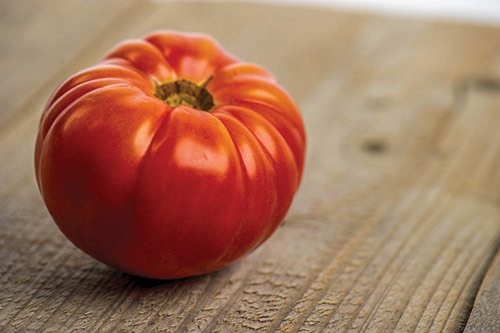Today, the humble tomato is one of the most popular vegetables grown in home gardens. Its present popularity is quite a success story because, according to the National Garden Bureau in the United States, the tomato suffered from bad PR for about 300 years.
Tomatoes originated in South America in the Andean mountains that overlap into the countries of Peru, Ecuador, Bolivia and Chile. Local natives may have eaten tomatoes, but no archaeological evidence indicates that they were cultivated in any way. It seems, however, that animals enjoyed these native tomatoes because historians speculate that they helped spread the seed some 2,000 miles northward to Central America.
It was the pre-Mayan Indians, the Aztecs, who first ate, cultivated and named the tomato (actually a wild cherry tomato). They called it ‘tomatl’ or ‘xtomatl’. The proper botanical name for the tomato is ‘Lycopersicon esculentum’ which translates literally as ‘edible wolf peach’.
In 1520, it is recorded that the Spanish explorer and conquistador, Cortez, saw some tomatoes in an early rudimentary market and brought the seeds home to Spain. From Spain, they ended up in Naples, which was under Spanish rule at the time. This is where the tomato apparently got its bad rap. Early herbologists thought the plant was related to the solanacaea family and was, therefore, as dangerous as deadly nightshade. A caption from an early description of the tomato states that “this new plant is more pleasant to the sight than either to the taste or smell, because the fruit being eaten provoketh loathing and vomiting”.
The tomato crossed back over the ocean, carried by early colonists. The poor tomato, however, just could not gain an improved reputation. Puritans felt that tomatoes were too sensuous looking, and therefore must be evil. It wasn’t until 1820 that the much maligned tomato actually got a break. World traveller, Colonel Robert Gibbon Johnson, collected tomato seeds from around the world and encouraged American farmers to grow them. To dispel the rumours about tomatoes being poisonous, Col. Johnson announced in 1820 that he would eat a whole basketful of tomatoes on the courthouse steps in Salem. Johnson’s personal physician claimed he would, “foam and froth at the mouth ... double over with appendicitis ... and expose himself to brain fever”. Well, Col. Johnson survived, to the amazement of all bystanders, and the tomato had a new beginning. Apparently, by 1835 they had become a part of the American diet. Tomatoes were used primarily in preserves, pickles and in ketchup. Cookbooks still warned that they should be cooked for at least three hours in order to lose their raw taste.
Well, things have changed. We now have hundreds of varieties of all types available, some with wonderful sweet flavouring. Today, a vine-ripened tomato is a real treat indeed, and you will be happy to know it is low in calories, too – just 22 for a medium sized tomato. Only lettuce, celery and radishes have fewer calories than tomatoes. Tomatoes are also a rich source of potassium and vitamin A. The vitamin C content of tomatoes is low when compared to citrus fruits, but when eaten raw, ripe and fresh, tomatoes are high in many vitamins and minerals. It is also one of the few vegetables with high concentrations of lycopene
With the May long weekend over, it is now the beginning of the tomato planting season. There are so many new, standard and heritage varieties, it’s hard to choose. We all have our favourites, but I try to select varieties with great flavour, disease resistance and early to mid-season maturity. Verticillium wilt, fusarium wilt and tobacco mosaic virus are the three most common disease problems. It’s important to look for varieties that have ‘V.F.’ or ‘T.M.V.’ behind their name. These letters indicate resistance to these diseases.
Many folks are confused by the terms ‘derminate’(D) and ‘indeterminate’(I) when applied to tomatoes. ‘Determinate’ basically means that the blooms and fruit develop on the plant within a relatively short time of one to two weeks, there’s a comparatively short harvest period and then the plants simply stop producing. Don’t let this deter you because you’ll get lots of fruit on shorter, more compact plants. ‘Indeterminate’ varieties produce blooms and fruit over a far longer period of time. If you have a greenhouse with heat, you can keep them going for months.
In next week’s article, I will write about the various tomato varieties and each ones unique features.
